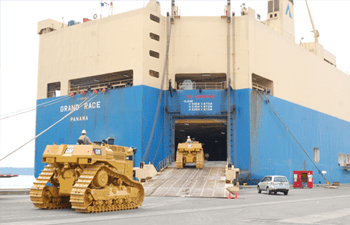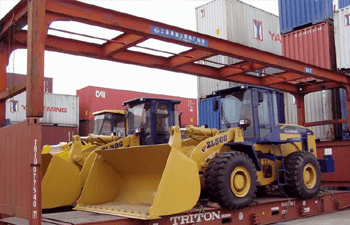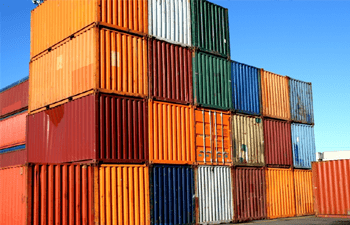Shipping heavy machinery is a big job – literally. When you’re dealing with power plants and components that weigh hundreds, if not thousands, of pounds traditional shipping over any long distance can prove exceptionally challenging. Throw in the additional requirements of international shipping and it’s perfectly understandable that some buyers or sellers would simply throw their hands in the air and pass on any offers coming in from overseas.
However, knowing your shipping options ahead of time means buyers and sellers need not pass up on the potential cash cow that is international machinery sales. While there are definitely more steps that need to be taken, they aren’t so daunting as to avoid shipping internationally entirely.
RO-RO Shipping
 One of the most common methods of shipping vehicles and heavy equipment is roll on-roll off shipping, or RO-RO. Almost exactly what it sounds like, this type of overseas shipping is designed for self-propelled machinery that can be driven on and off of the transport ship on wheel, treads or tracks. While RO-RO shipping is extremely common, it can also require a great deal of lead time. Space on RO-RO ships is in high demand and space for heavy machinery can be reduced or eliminated with little notice. Shipping to or from ports during a high volume season – like Japan during the rollout of a new year of vehicles – can also mean the need for flexibility on the part of buyers and sellers.
One of the most common methods of shipping vehicles and heavy equipment is roll on-roll off shipping, or RO-RO. Almost exactly what it sounds like, this type of overseas shipping is designed for self-propelled machinery that can be driven on and off of the transport ship on wheel, treads or tracks. While RO-RO shipping is extremely common, it can also require a great deal of lead time. Space on RO-RO ships is in high demand and space for heavy machinery can be reduced or eliminated with little notice. Shipping to or from ports during a high volume season – like Japan during the rollout of a new year of vehicles – can also mean the need for flexibility on the part of buyers and sellers.
Flat-Rack Shipping
 For machinery and equipment that cannot be driven on or off of a vessel, flat-rack shipping is an option. Similar to being loaded onto a flat-bed truck, these open containers come in 20-40ft dimensions and can support up to 67,000 pounds. These open-style racks also come with tethers to secure machinery safely to the bed of the rack and side walls still allow for stacking once on-board the ship. If used for machinery, these types of shipping racks may require the shipper to disassemble components in order to fit within the confines of the shipping rack.
For machinery and equipment that cannot be driven on or off of a vessel, flat-rack shipping is an option. Similar to being loaded onto a flat-bed truck, these open containers come in 20-40ft dimensions and can support up to 67,000 pounds. These open-style racks also come with tethers to secure machinery safely to the bed of the rack and side walls still allow for stacking once on-board the ship. If used for machinery, these types of shipping racks may require the shipper to disassemble components in order to fit within the confines of the shipping rack.
Container Shipping
 Probably the most common type of overseas shipping that comes to mind, container shipping is similar to open flat-rack shipping in dimensions and weight limits, but completely enclosed. This type of shipping method will likely require any machine to be disassembled, at least in part, and may also require more than one container to accommodate all of the components. For unusually tall machinery, open-top containers are also available as well as refrigerated containers should temperature control be an issue.
Probably the most common type of overseas shipping that comes to mind, container shipping is similar to open flat-rack shipping in dimensions and weight limits, but completely enclosed. This type of shipping method will likely require any machine to be disassembled, at least in part, and may also require more than one container to accommodate all of the components. For unusually tall machinery, open-top containers are also available as well as refrigerated containers should temperature control be an issue.
Select a Shipper & Customs Services
After you’ve settled on the type of shipping you need to accommodate your machinery shipment, the next step is to find a shipping and logistics company that has the experience to schedule, reserve and arrange proper documentation. It’s also important to discuss customs services with your shipping coordinator. Depending on the shipper, customs services may or may not be included in the shipping fees. You may also need to seek third party assistance for customs services if they aren’t offered through your shipper.





